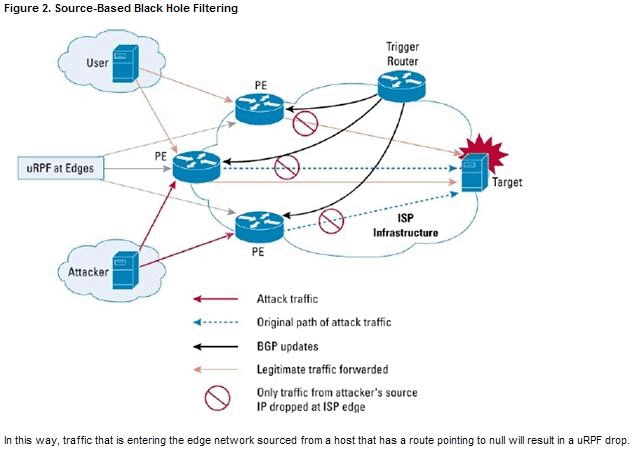When implementing source-based remote-triggered black hole filtering, which two configurations are required on the edge routers that are not the signaling router? (Choose two.)
When implementing source-based remote-triggered black hole filtering, which two configurations are required on the edge routers that are not the signaling router? (Choose two.)
A . A static route to a prefix that is not used in the network with a next hop set to the Null0 interface
B . A static route pointing to the IP address of the attacker
C . uRPF on all external facing interfaces at the edge routers
D . Redistribution into BGP of the static route that points to the IP address of the attacker
E . A route policy to set the redistributed static routes with the no-export BGP community
Answer: A,C
Explanation:
Source-Based RTBH Filtering
With destination-based black holing, all traffic to a specific destination is dropped after the black hole has beenactivated, regardless of where it is coming from. Obviously, this could include legitimate traffic destined for the target. Source-based black holes provide the ability to drop traffic at the network edge based on a specificsource address or range of source addresses.
If the source address (or range of addresses) of the attack can be identified (spoofed or not), it would be betterto drop all traffic at the edge based on the source address, regardless of the destination address. This wouldpermit legitimate traffic from other sources to reach the target.
Implementation of source-based black holefiltering depends on Unicast Reverse Path Forwarding (uRPF), most often loose mode uRPF.
Loose mode uRPF checks the packet and forwards it if there is a route entry for the source IP of
the incomingpacket in the router forwarding information base (FIB). If the router does not have an FIB entry for the source IP address, or if the entry points to a null interface, the Reverse Path Forwarding (RPF) check fails and thepacket is dropped, as shown in Figure 2. Because uRPF validates a source IP address against its FIB entry, dropping traffic from specific source addresses is accomplished by configuring loose mode uRPF on the external interface and ensuring the RPF check fails by inserting a route to the source with a next hop of Null0.
This can be done by using a trigger device to send IBGP updates. These updates set the next hop for the source IP to an unused IP address that has a static entry at the edge, setting it to null as shown in Figure 2.


